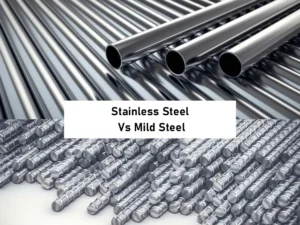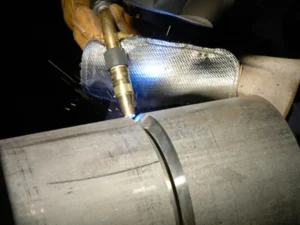Have you ever thought about welding stainless steel to mild steel? It is a cost-effective way of making any product with excellent rust resistance. However, the question arises: can you weld stainless steel to mild steel?
Yes, it is possible to weld the stainless to mild steel. However, it is a very complex process due to the stainless steel’s higher thermal expansion and lower thermal conductivity. Due to these issues, the weld can wrap or crack. So, expert welders are required to get the job done.
It is essential to understand the properties of these two metals before welding them. This guide will give you an insight into welding mild steel to stainless and getting solid welds. So, let’s get started!
Stainless Steel vs Mild Steel – Basic Differences

Both of these metals have different properties that make welding hard. Knowing them will help you get strong welds by applying proper heat. Some of those differences are as follows:
- Mild steel is cheap and offers less strength. On the flip side, stainless steel is strong, premium, and expensive. It looks sleeker and more attractive than mild steel, which looks dull.
- Stainless steel is super strong and rust-resistant. The reason is that it consists of 10.5% of chromium. When reacted with oxygen, the chromium makes a strong layer of chromium oxide that offers ideal resistance against rust. Mild steel is also durable. However, it is not rust-resistant and does not contain chromium.
- Stainless steel has higher thermal expansion than mild steel. In simple words, stainless steel quickly changes and expands when heated. The mild steel has low thermal expansion. Due to this property difference, it becomes complex to weld them together.
- Stainless steel has low thermal conductivity, which poses a massive challenge when welding it with mild steel. Low thermal conductivity means that it does not conduct heat quickly. Heating the stainless steel will remain warm for longer as it does not move away from the heated area.
By understanding these differences, you’ll know whether it is possible to weld stainless steel to mild steel and, if it is, what factors need to be under your control.
Is it Possible to Weld Stainless Steel To Mild Steel?

Yes, it is 100% possible to weld the stainless steel to the mild steel that does not contain chromium. However, you will have to give controlled heat with optimal speed. These two control standards will help overcome the lower thermal conductivity of the stainless steel.
The stainless steel is sensitive to heat. It expands and stresses the weld on heating, which is a big challenge when welding it to mild steel. As you know, welding works when you provide intense heating. But, in our case, the provision of excessive heat will expand the stainless, and you will get weak welds.
The low thermal conductivity is another severe issue you’ll have to face while welding. The stainless steel has low thermal conductivity. It means it does not move away from the heat quickly. Heating the stainless steel part will take a lot more time due to lower thermal conductivity.
On the other hand, mild steel offers excellent thermal expansion and decent thermal conductivity. Due to these differences, welding them together is very tricky. That is why I mentioned earlier that this welding will require an expert welder with experience welding at controlled heat.
Guidelines to Follow When Welding Stainless to Mild Steel
Challenges are severe when it comes to welding stainless to carbon steel. However, a few things can help you avoid the issues such as weak welds, porosity, wrapping, and cracking.
1- Control Heat
As I said earlier, the stainless steel cracks during welding due to its higher thermal expansion. When you heat it, it expands in size, causing wraps, cracks and weaker welds. To cope with this issue, you’ll have to provide the heat in a controlled manner.
Usually, during welding, the welders provide massive heat. Due to this intense heat, the material melts, and the filler binds two metals. However, while welding stainless to mild steel, you must provide heat in breaks and lower amperages. You should use a backstepping method of heating.
During welding, provide heat, stop for seconds, and let the stainless steel absorb the heat. After a few seconds, heat the stainless steel again. In this manner, you’ll be able to control the thermal expansion of the stainless steel and weld it with mild steel with low thermal expansion.
2- Speed of Heat
The second issue that welders usually face during welding is the low thermal conductivity of stainless steel. This metal does not move the heat away from the heat part. It will take a long time for stainless steel to cool.
If the heated part remains hot and heat does not dissipate quickly, it can also cause thermal expansion. To cope with this issue, you’ll have to provide the heat at high speed. The reason is that it will melt both stainless and mild steel quickly and form joints between them.
Once the joint is made, you can leave the metal to cool. Mild steel has higher thermal conductivity and will cool faster than stainless steel. However, if you don’t provide heat with optimal speed, the stainless steel will melt fast and won’t cool quickly to form a joint or weld with mild steel.
3- Cleaning the Surface
Stainless steel contains 10.5% of chromium, ensuring it won’t get any rust. Chromium reacts with oxygen to make an invisible chromium oxide layer that does not rust. On the other hand, mild steel does not contain chromium and usually rusts easily.
So, when welding both of these metals, it is imperative to clean the surface of mild steel and remove rust and other contaminants. If a slight amount of rust is present on the surface of mild steel, it will cause cracking and pores in the weld almost immediately when you weld them.
4- Filler Type
Using the wrong filler can be a headache as it can waste all the hard work. If you use mild steel filler, it will cause rust and corrosion. The weld will crack and damage itself due to the rust induced by using the wrong filler.
Ideally, you should use a 309L stainless steel filler rod. The reason is that this filler will offer excellent resistance to rust because it contains chromium. The rust won’t affect the weld; you’ll get a strong bond between stainless steel and regular steel.
5- Use Corrosion-Resistant Coatings
Although this is not mandatory, it proves helpful if you paint the weld and apply a thin epoxy coating. The reason is that this coating will protect the weld from corrosion in the future. Remember that weld contains mild steel that can get rusted over time.
However, if you paint the weld, it will ensure its longevity. This small step adds no extra cost to your project and can save you worries in the future. Your welding will remain solid and rust-free for years to come.
Note: We’ve put together a guide comparing Mild Steel and Carbon Steel. If you’re curious about how they differ, take a look at our guide for more information.
Techniques For Weld Stainless To Mild Steel

Different welding methods exist; however, TIG and MIG are the most famous for welding stainless steel with carbon steel. Both methods use suitable filler to get the job and make strong weld.
TIG (Tungsten Inert Gas) welding type is helpful for getting 100% accuracy with a very small, sleek weld. On the other hand, the MIG (Metal Inert Gas) does not make a sleek weld design and is useful when you aim to get a strong weld and don’t care about its design.
You’ll have to use inert gas in both TIG and MIG methods. Usually, 98% of argon (an inert gas) and 2% of carbon or oxygen are used as shielding glasses. Both of these methods offer their pros. However, the TIG welding method is slightly more expensive than its counterpart.
MIG vs TIG: Which is Suitable for Welding Stainless to Mild Steel?
MIG and TIG offer excellent welding solutions and make strong welds, even if you are welding stainless steel or mild steel. However, I suggest the MID method if you need clarification on these two types.
The MIG welding method is inexpensive and offers more robust welding with a slightly bad-looking design. It also provides excellent performance when welding thicker stainless to mild steel parts.
If you aim to make something that should be aesthetically pleasing, then the TIG method would be your way to go. It also makes very accurate welds with clean shapes and appearance when welding the thinner parts. However, the TIG welder machines are expensive, which you must also remember.
If you prefer the durability and strength of the weld over its design and shape, go with the MID welding type. For welding thicker parts, the MIG welding method offers the best solution. Ultimately, it is all about your preferences and needs.
Note: Does Tesla’s Cyber Truck use 30X cold-rolled stainless steel? Is it a myth or a reality? Our detailed guide will give you insight.
Why Manufactures Welds Stainless to Mild Steel?
As you know, welding both of these materials is a complex process. It requires a higher level of control and precision. So, the question comes: why do we weld them? Such a question is common among those relatively new to welding work.
Welding stainless steel to mild steel is a wise choice. It’s cost-effective and yields strong products. Welding pricey stainless steel with budget-friendly mild steel gives you a rust-proof and durable end product. At the same time, the remaining parts are made with mild steel.
For example, in heavy-duty conveyor belts, the parts bearing the loads are steel. On the other hand, the parts that don’t bear weight are less important and are usually made with mild steel as it helps control them overall.
Without using mild steel, the manufacturers had to use complete stainless steel, which would have increased the price too much. This is just one example to help you understand why the manufacturers weld the stainless to mild steel.
Conclusion
Although welding stainless steel to regular steel is complex, it is very doable. With the proper technique and skill set, welders can weld them together. Considering their properties, you can effectively weld these two metals.
One thing that you must remember is that slight mistakes during welding will end up giving you a weaker or cracked weld. To prevent issues, analyze materials, understand properties, and apply heat wisely.
